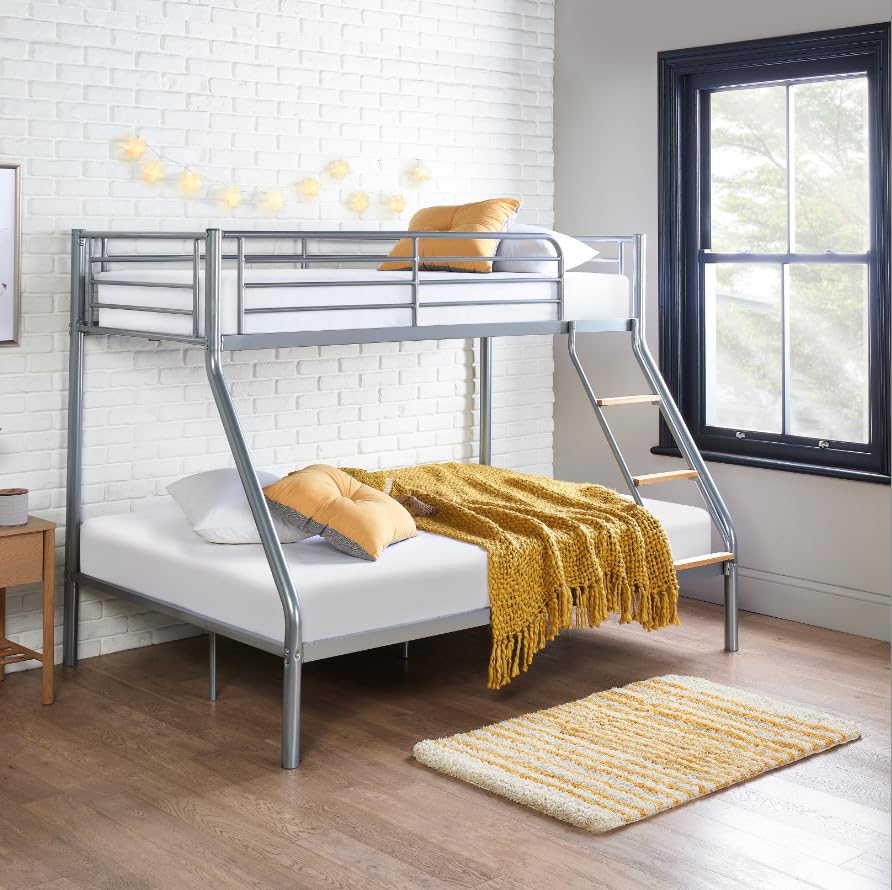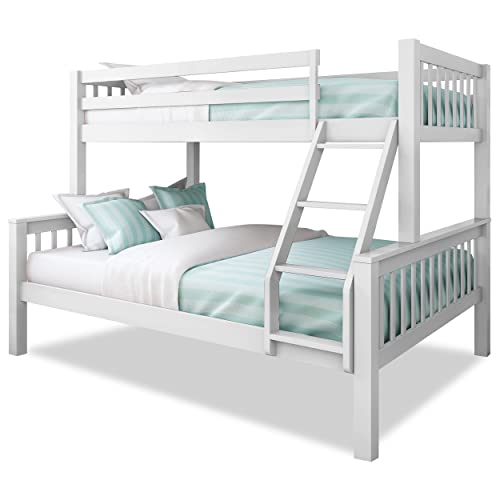Triple Bunk Bed
Triple bunk beds are an excellent solution for those who have space at a minimum. They can accommodate multiple sleepers comfortably. High-quality bunk beds are durable and can withstand the combined weight of three persons without compromising safety or stability.
Regular inspections of your bunk beds single over double bed could help you spot problems early and prolong the life of your bed. Proper cleaning and care can prevent water damage, insects infestations and other issues that can compromise the structural solidity of your bunk bed.
Benefits
Triple bunk beds are an excellent method to maximize space in a child’s bedroom. Stacking three beds vertically saves space on the floor, making space for additional furniture and creating an open and clutter-free living environment. The stacked design promotes cleanliness as personal belongings are easily stored in designated spaces that correspond to each bed. This promotes an awareness of ownership and responsibility of one’s own personal space.
A 3 Bunk bed (wiese-krag.thoughtlanes.net) can also offer more sleeping space than other alternatives. This makes it an ideal choice for families with multiple children, or for those who frequently host guests. You can find triple bunk beds that have separate twin beds or full-size beds on the lower level. Some models come with a trundle pull-out bed, which can be used as an additional bed for guests.
These beds can also offer the perfect setting to bond and foster sibling relationships because they let siblings share a space while still maintaining their privacy. The close proximity of beds also fosters a sense of companionship which encourages them to spend more time together reading, playing games, or sharing secrets. This sharing spirit extends to other aspects of their lives, positively affecting the quality of their relationships as adults.
A triple bunk bed is an excellent way to make space and also enhance the look of your house. A lot of models have a beautiful wood finish that complements the decor. Some models come with a built-in staircase that enhances the overall look of the room. Some designs include under-bed storage which can be used to store books, toys or bedding.
It’s important to think about safety when purchasing bunk beds regardless of the style. To ensure stability, make sure the model you choose is able to meet the weight requirements and is constructed of durable materials. Additionally, make sure the bunks have railings on both sides to stop children from falling off. It is also important to ensure that the ladder is sturdy and easily accessible so that your children can climb safely without being injured.
Design
 Triple bunk beds are a great solution for smaller spaces. The beds are available in many sizes, ranging from twin XL size to queen size, which can accommodate growing children or guests. They can also be customized with extra features such as desks, shelves or under-bed storage drawers to maximize their multifunctionality. This makes them suitable for a variety of decor styles, from contemporary to traditional, and fits well in rooms of various dimensions.
Triple bunk beds are a great solution for smaller spaces. The beds are available in many sizes, ranging from twin XL size to queen size, which can accommodate growing children or guests. They can also be customized with extra features such as desks, shelves or under-bed storage drawers to maximize their multifunctionality. This makes them suitable for a variety of decor styles, from contemporary to traditional, and fits well in rooms of various dimensions.
The most commonly used design for a 3 bunk bed is one full size on top and two twins on the bottom. This arrangement provides plenty of sleeping space for three while maximizing floor room for play and storage. A twin-over-twin stacked design is also a good option for siblings sharing in a bedroom. If you are looking for a better efficient solution, you could consider a corner triple bunk bed which allows you to make use of the space in the room while offering easy access to both upper bunks via ladders or a staircase.
A free-standing triple bed with a staircase and ladder for the top bunk is also a popular choice. This kind of bunk bed are ideal for kids’ bedrooms with high ceilings. It gives plenty of head space, while still leaving space for dressers, nightstands, and other furniture. This kind of bunk bed can be customized by adding a slide for additional fun.
When building a bunk bed that is stacked it is essential to select an extremely durable and sturdy structure that can stand up to daily use. Many manufacturers use a combination of woods, metals, and plastics in their designs and some even offer an assurance of long-lasting durability. Metal brackets are used to secure beds to the wall. This prevents warping, and ensures the bed’s stability and safety.
When assembling the frame of a triple bunk bed, it is crucial to take measurements and mark each leg of the bunk to ensure that it fits the mattress correctly. If you are building a stacked bed with the middle bed being different height from the bottom bunk, make sure to cut each 2×2 at a length that will allow it to fit around the leg of the bottom bunk. You might also want to cut a 2.5″ square from each corner of the plywood to allow it to be able to fit around each leg.
Materials
A triple bunk bed can be a great solution to saving space in a shared child’s room. It helps save floor space and eliminates the necessity for additional furniture, which makes it perfect for families with limited space. In addition, this type of bed is typically made from durable and strong materials, so it can hold three kids without any compromise in safety or comfort.
You can customize a diy triple bunkbed to fit your preferences for space and style. You can add visual interest by applying different paint colors and wood finishes. Lighting can also add to the ambiance of the room. For instance, you could install LED strip lights underneath the beds, or even fairy lights on the headboards to create a whimsical look. But, make sure to keep the lighting safely installed and out of the reach of children.
To construct your triple bunk bed begin by cutting 2×6 boards and plywood sheets to the necessary lengths. You’ll need a table saw to complete this task. After you have the boards cut, sand them down for a smooth finish. Then, fix the frames with wood screws.
You’ll need two long sides and one short side to make the bottom bunk. Choose a piece that is 71 inches long for the long side, and a 39-inch piece for the shorter side. The width of the 4×4 leg which will go through these sections of the frame will be the difference in size.
After the frame is assembled, connect the slats using pocket holes. Make sure to drill into the ends of the slats, so that the screw heads aren’t visible from the front of the bed. Do not forget to glue the slats prior to installing them.
Installing the ladders is the final step. You will need 1×2 trims to do this. Attach them by using pockets to the rails of the ladder, double and single bed bunk then attach them using brad nails to the supports. Be sure to measure the distance between the top of each ladder and the edge of the bunk at the bottom to ensure it’s exactly the same as the measurement for the top railing.
Safety
If properly maintained and constructed, bunk beds are extremely secure. If you choose a design that meets the national safety standards and using robust, durable materials you can reduce the risk of collapse. Also, ensure that all fittings are tightened before use. Bunk bed safety can be improved by following safety guidelines, educating children how to use the ladder in a safe manner and ensuring the space around the bunk bed is free from hazards like toys, books and clothing.
It is crucial to choose a bunk bed that has mattress platforms rather than box springs, as these are safer and can support the weight of each sleeping person without stressing the frame. It is also recommended to inspect the foundations of your mattress often for signs of wear and tear out. If there is a need for a box spring for a bunk bed it is a good idea to make use of a foundation that is low-profile and rests on the rails of the bunk bed. This will decrease the risk of head injuries and roll-off accidents.
Make sure that the guardrails on either side of the upper bunk are sufficiently long to prevent the entrapment. If the gap between the guardrail and the top of your mattress is too wide you could be at risk of strangulation. On the side of the guardrail that is closest to the wall, the gaps should be small enough so that the head of a child cannot pass through the gaps.
Children should only climb into their bunk beds using the stairs or ladders that are provided, not climbing onto other furniture or jumping off from the floor. To prevent falling and tripping, ladders should be placed away from light fixtures such as plug sockets, ceiling fans as well as windows. It is a good idea to encourage children to sleep on the lower bunk, when they are less than six years old. This can also deter rough play or playing on the bunks.
Discourage horsing around on the top bunk and encourage only one person to sleep in the upper bunk at a time. If the bunk on top for playing is used, it can cause serious injuries in the event that someone falls and hits their head.
